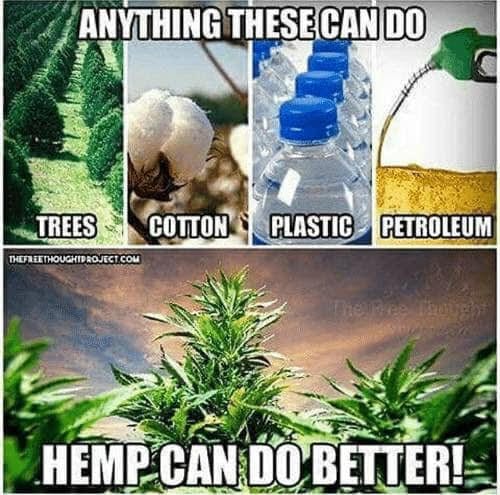By now, many people are aware that “Western Medicine” was created in the early 1900s by none other than John D. Rockefeller himself. Already having a monopoly on the petroleum industry, he saw a huge opportunity to control the chemical and medical industries as well. In his pursuit to take over the medical industry, he used smear campaign tactics in order to remove his holistic competition and gain a monopoly of the industry to push his petroleum-based, synthetic pharmaceuticals. By pushing out the natural medicine practiced for thousands of years, he could patent his petrochemicals and take control.
But what if I told you this was just the tip of the iceberg when it comes to the outlawing of hemp?

We have become so conditioned to automatically think of marijuana and THC whenever we hear the terms “cannabis” or “hemp” mentioned, we completely overlook the agricultural and industrial aspects of this “evil species of greenery.” What if I told you the financial gain from industrial hemp far outweighs that of medicinal cannabis? We can even take it a step further! What if I told you the recreational use of cannabis for those seeking the high of THC is, in fact, at the bottom of the totem pole when it comes to the trillions of dollars this one crop alone can create for local economies? From building materials, textiles, paper products, medicines, and more, like over 25,000 products more to date, this crop could, and probably would, crush the monopoly big corporations have over the majority of our industries considering it can be grown in almost every environment all over the world and cannot be patented due to the fact that it’s derived from nature. And, oooh, those big boys hate that!
As stated above, the hemp plant can be used from root to tip for many different products but for this article, we’re going to go back in time and focus on paper.

You may ask, “Why paper of all things?” Believe it or not, paper had one of the biggest roles in causing hemp to become illegal.
in 1916, not long after the release of USDA Bulletin 404. a man by the name of George Schlichten, a 50-year-old German immigrant who had been working on a simple, yet brilliant invention came into play. Schlichten had spent 18 years on the decorticator, a machine that could strip the fiber from nearly any plant, leaving the pulp behind. To build it, he developed an extensive knowledge of fibers and paper making. He desired to stop the felling of forests for paper, which he believed to be a crime. His native Germany was well advanced in forestry and Schlichten knew that destroying forests meant destroying needed watersheds.
During this time, turn-of-the-century newspaper barons needed huge amounts of paper to deliver their swelling circulations. Nearly 30% of the four million tons of paper manufactured in 1909 was newsprint; by 1914 the circulation of daily newspapers had increased by 17% with an estimated growth of over 28 million copies. By 1917, the price of newsprint was rapidly rising, which caused some concern for those looking to invest in the paper mill industry. Schlichten had thoroughly studied many kinds of plants used for paper, among them were corn, cotton, and yucca… hemp, however, seemed to be his favorite. His hemp paper was even better than what was produced for USDA Bulletin 404, because his decorticator machine eliminated the retting process, which is the process employing the action of bacteria and moisture on plants to dissolve or rot away much of the cellular tissues and gummy substances surrounding bast-fiber bundles, leaving behind short fibers and a natural glue that held the paper together. By 1917 levels of hemp production Schlichten anticipated making 50,000 tons of paper yearly at a retail price of less than 50 percent of the price of newsprint at the time! Schlichten also noted that each acre of hemp turned into paper would preserve almost five acres of forest. Sadly, during this time, instead of embracing new, cost-effective technology, newspaper giants made the decision to take the easy way out and raise their prices as many corporate giants do.

It wouldn’t be until the 1930s that we would see the decorticator machine resurface when it was dubbed by articles in Mechanical Engineering and Popular Mechanics as the machine that would make hemp a “Billion Dollar Crop”. “Modern technology was about to be applied to hemp production, making it the number one agricultural resource in America.. and thousands of new products, creating millions of new jobs, would herald the end of the Great Depression!” Instead of this happening, thanks to the bidding of W.R. Hearst, hemp was persecuted, outlawed, and forgotten.
Enter Hearst, DuPont, and Mellon who was DuPont’s chief financial backer.
In the mid-1930s, when the new mechanical hemp fiber stripping machines and machines to conserve hemp’s high-cellulose pulp finally became state-of-the-art, available, and affordable, the enormous timber acreage and businesses of the Hearst Paper Manufacturing Division, Kimberly Clark (USA), St. Regis, and virtually all other timber, paper and large newspaper holding companies, stood to lose billions of dollars. Not to mention at the same time, DuPont had just patented processes for making plastics from oil and coal, as well as a new sulfate/sulfite process for making paper from wood pulp. However, competing against environmentally friendly and cost-effective hemp paper and natural plastic technology would have jeopardized the lucrative financial schemes of Hearst, DuPont, and DuPont’s chief financial backer, Andrew Mellon of the Mellon Bank of Pittsburgh.
Let the “Yellow Journalism” begin! Different name, same media lies!
What we now call propaganda was once referred to as “yellow journalism” and during the mid-1920s, Hearst began the smear campaign against hemp running stories implicating the use of “marijuana” (a term never used in the States before this time) in lurid accounts of horrible traffic disasters, whole-family mutilations, and various other irrational acts stating, “Marijuana makes these acts completely logical to its pitiful captives, who have become slaves to its false promise,” claiming the perpetrators were Mexicans, Puerto Ricans, and other “dark-skinned folks.” Sound familiar?
The added influence of Henry J. Anslinger
Upon Alcohol becoming legal in 1933, Harry J. Anslinger became the first director of the newly formed Federal Bureau of Narcotics, now known as the DEA, and strongly opposed hemp. Because of his influence, American society as well as politicians started to view government and law enforcement officials as the only “experts” on marijuana.
On April 14, 1937, Herman Oliphant introduced the Marihuana Tax Act bill directly to the House Ways and Means Committee instead of to other appropriate committees such as Food and Drug, agriculture, textiles, commerce, etc. His reason may have been that “Ways and Means” is the only committee that can send its bills directly to the House floor without being subject to debate by other committees. Ways and Means Chairman Robert L. Doughton, a key DuPont ally, was quick to rubber-stamp the bill and sent it sailing through Congress to the President.
So, it begs the question…Is hemp that “evil green plant” we were raised to fear, or is the banning the outcome of malicious greed? You tell me!

